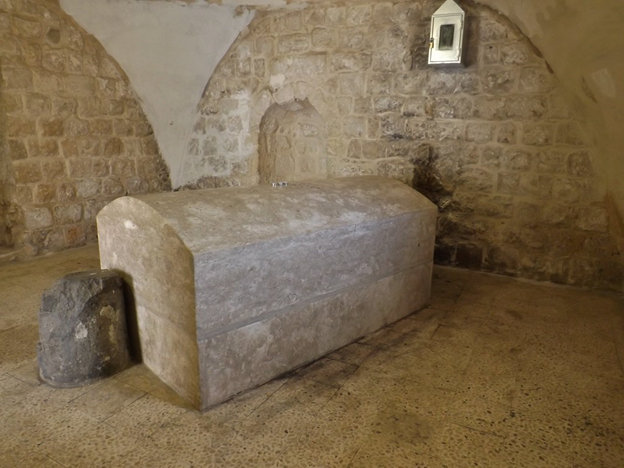
How to (safely) visit the Tomb of Joseph
“And Jacob came safely [to] the city of Shechem, which is in the land of Canaan, when he came from Padan aram, and he encamped before the city. And he bought the part of the field where he had pitched his tent from the sons of Hamor, the father of Shechem, for a hundred kesitas. (Genesis 33: 18-22)”
“And the bones of Joseph, which the children of Israel had brought up out of Egypt, they buried in Shechem, in the parcel of ground which Jacob bought from the sons of Hamor the father of Shechem, for a hundred pieces of money (Joshua 24:32)”
Today we are visiting a site so off the beaten track, that Jews (and often Christians) can only safely visit here once a month! Not only does the Tomb of Joseph (located in the Arab city of Nablus) have major religious, historical, and political significance, but is also mentioned explicitly many times in the Bible!
In Biblical times (and still today colloquially among Hebrew speakers) the city of Nablus was called Shechem and is one of the world’s oldest cities. It was here where G-d first appeared to Abraham after he entered the land of Israel, telling him that that it would be given to his descendants (see Genesis 12: 6-7).
Two generations later Jacob, who had spent 20 years in Haran (today southern Turkey) working for his father-in-law Laban, returned to Israel with his wives and children. Along the way, he crossed the biblical Gilead Mountains and Jabbok River (today in Jordan). (For more on these two great biblical sites, click here). He then entered Israel, on route to Shechem (roughly today’s highway 57) . Once there he bought a field (see Genesis 33:18-19) and on his deathbed gave it to Joseph (see Genesis 48:22).
On Joseph’s deathbed, he had his brothers promise that when their descendants would leave Egypt, they would take his bones with them (see Genesis 50: 24-26). According to Jewish sources, after his death the abundant material blessings that came to Egypt in the merit of the very righteous Joseph had ceased. In order to bring blessings to the Nile River (whose yearly overflow made Egypt the breadbasket of the ancient world) they put his body in an iron coffin and sank it into the Nile.
When it was time for the Children of Israel to leave Egypt, Moses went to retrieve Joseph’s bones from the river (see Exodus 13:19). According to Jewish sources, he used the divine name to bring up the coffin from the river’s depth.
When the Children of Israel crossed into Israel, they buried Joseph in the field that his father had purchased in Genesis 33 (see Joshua 24:32). It is interesting to note, that the verses in Genesis and Joshua both mention that Jacob bought and paid for the land. Why is that important to mention, and why did Jacob purchase something which G-d had promised him for eternity? According to Jewish sources, there are three biblical places where the Jewish people bought the land (even though G-d had given it) so that no one should later claim that they were stolen (as many in the UN claim today): The Cave of the Patriarchs in Hebron (for more, click here), the Temple Mount, and Joseph’s tomb.
For the next few Millenia Joseph’s tomb became an important holy site, where Jews from around the world came to pray. In 1868 the British consul in Damascus gave the money to build the domed building over the grave, which we see today.
Between 1948-67 Jordan controlled Shechem, and Jews were prohibited from visiting. After the 6-day war, the site once again became accessible to Jews, and in 1984 a full time Yeshiva (Academy of advanced Torah and Talmudic studies) opened at this site. In 1995 Israel gave control of Nablus and its surrounding environs to the Palestinian Authority (PA), although the IDF retained control of this holy site.
In October 2000 with the start of the intifada and major disturbances in the Nablus area, the IDF banned Israelis from visiting the site. It was then handed it over to the PA police, where the site was immediately torched, the Yeshiva burnt down, and Jewish holy books were torn to shreds. For the next decade, Jews continued to be banned from visiting. Thanks to the hard work and dedication of Jewish activists (including many from the Chassidic Breslov movement) Israel began to allow Jews to return once a month, in the middle of the night, with an army escort in bullet proof buses (during this time, renovations were also done to fix much of the damaged building). The rest of the time, it is off limits.
The tomb of Joseph is certainly well worth the visit for anyone looking for an uplifting experience. For those who do not have the opportunity to join an IDF-protected group, the tomb can still be safely viewed from nearby (and stunning) vistas. That being said, it is considered dangerous for individuals and groups to enter this site without coordinating with the IDF. In the absence of an organized IDF escort, NO ONE should enter this site.
Nosson Shulman is a journalist and Licensed Tour Guide in Israel specializing in Biblical tours. To allow tourists to experience Israel during the Corona era, he created the new hit Israel tour video series which brings Israel to the home of viewers by simulating actual tours. To check out his free sneak preview tour videos, click here. To view sample tour itineraries or to inquire about private tour opportunities with a personalized itinerary on your next trip to Israel, click here.
The post How to (safely) visit the Tomb of Joseph appeared first on Israel365 News.
Israel in the News